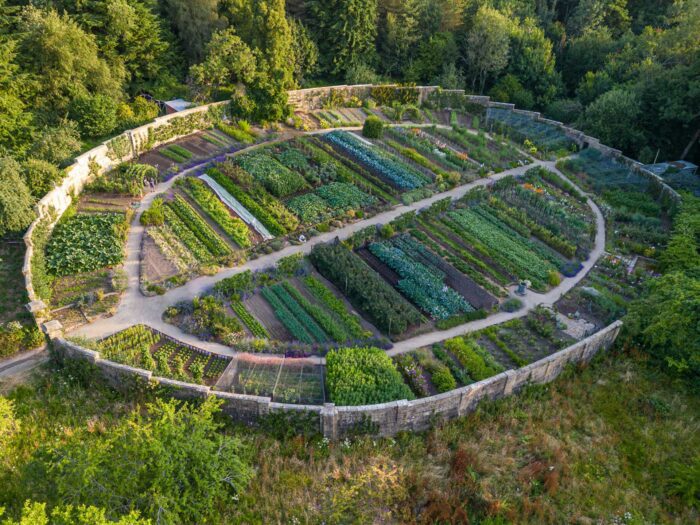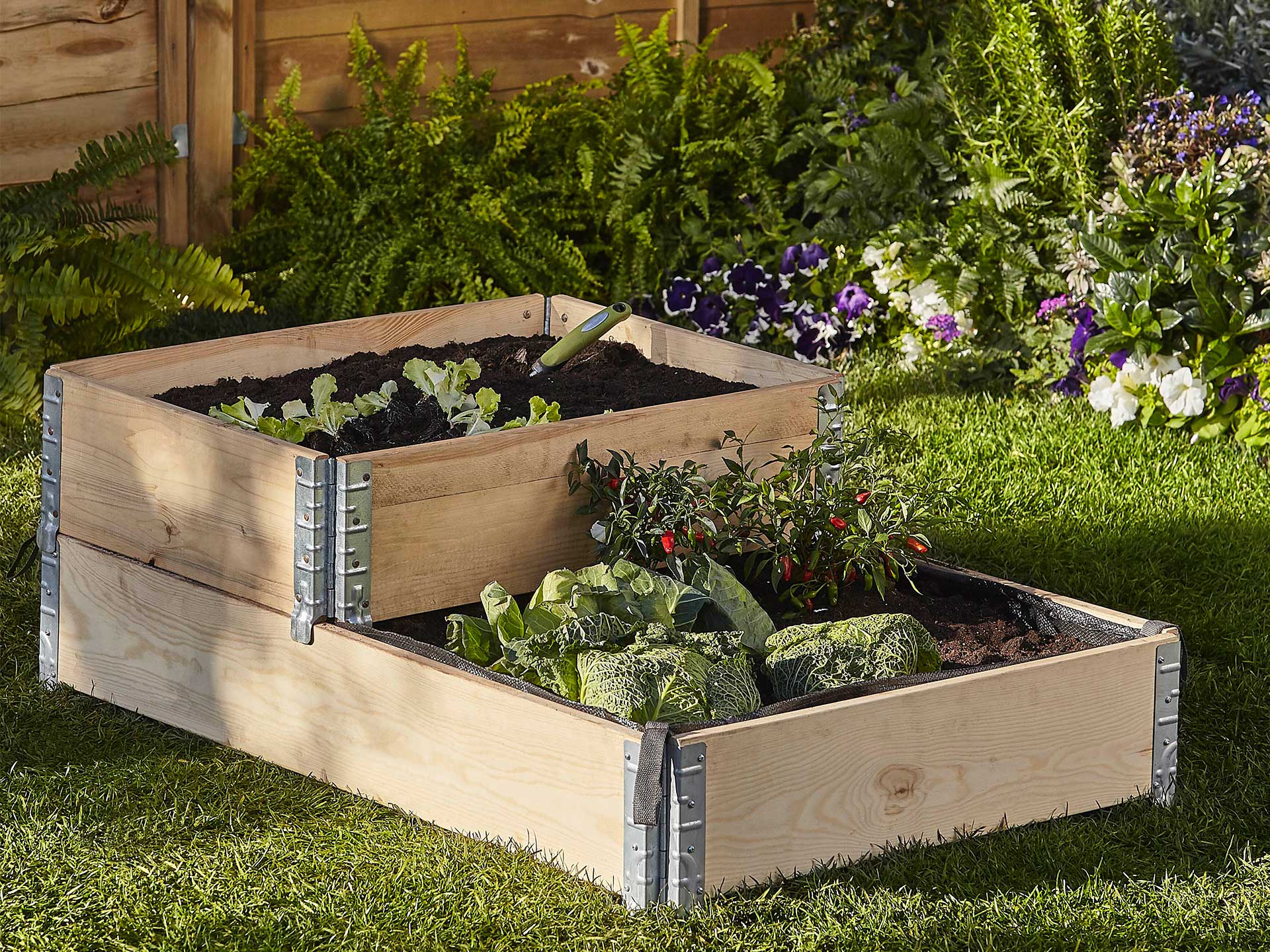
Image credit: B&Q
Start a kitchen garden – with inspiration from Chelsea Flower Show
Starting your own kitchen garden and nurturing it can bring a huge amount of joy and satisfaction. A kitchen garden is often smaller and more compact than a full vegetable garden and is usually located near the kitchen for convenience – a space to nip out and pick salad leaves or herbs when you need them. Being able to harvest and cook with your own produce can transform your relationship with fresh produce and nature.
Growing your own food is cost-effective, often times far more delicious, and much better for you. It’s environmentally beneficial, means no wasted food miles, and it eschews plastic packaging completely. Food waste is kept to a minimum with a kitchen garden and you can share any surplus with your local community. Here’s what to know about getting started.
Decide your soil type and where to plant
Proper planning and site selection are key to developing a thriving kitchen garden. Although you’ll want to be as close to the kitchen as you can, also choose a spot that gets the most amount of sun as possible. Think about your available space and budget and how much time you have. The trick is to prioritise growing veg, fruit and herbs yourself that are more expensive in the shops – things like leeks, aubergine, asparagus or heirloom tomatoes – and buying the produce that’s relatively cheaper like onions at markets.
Determining your soil type is also a big factor. RHS say, “If you have a cold, clay soil (which takes longer to warm up in spring) then early crops are tricky, but later crops should be abundant and need relatively little watering. Using raised beds can help the soil warm up quicker.”
They add, “Light soils, on the other hand, are great for early crops, but can be dry and unproductive later. There is no point struggling against the nature of your soil, so if you have a clay soil consider raising early crops in containers and if yours is a light soil, grow late-maturing crops in shallow trenches that are easy to fill with water for ease of irrigation.”
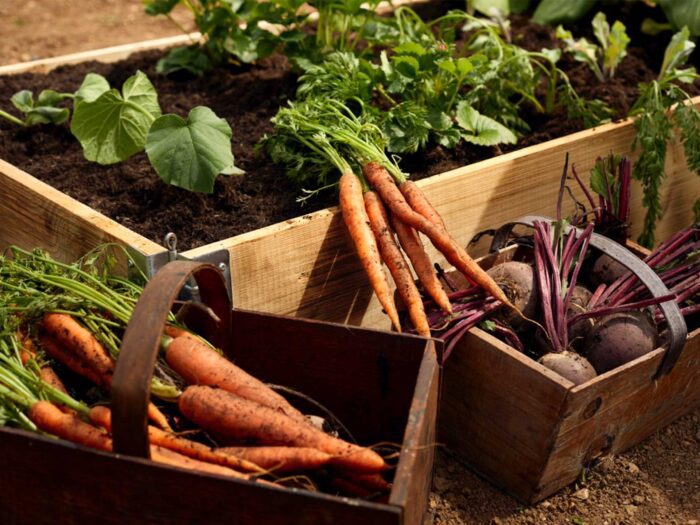
Think about the type of planting
Many Victorian houses in the UK have a brick-walled garden. These are brilliant for establishing an inner-micro climate as the brick retains the heat well (especially great if you’re growing fruit and vegetables up the walls), and helps in crop growth. It also adds protection from the elements and predators. Although you can grow in any type of garden, even a balcony. Here are the main types:
Traditional in-ground planting – If you’ve got good soil that gets plenty of sunlight, then you can create your kitchen garden directly in the ground. If the conditions are right, this is the most cost effective way of planting. It’s also great for planting crops with long roots.
Raised bed planting – If you have poor soil, then raised beds are a brilliant option of bringing better growing conditions to your garden. Multiple smaller raised beds are better than one long bed, although make sure you can get a wheelbarrow between the beds for bigger plots.
Go for widths of less than 1.5m (5ft) too, so you can reach to the other side easily, without standing on the soil. If you are going for long beds, RHS suggests planting them from north to south for even sunlight levels.
When it comes to depth, RHS says, “30cm (1ft) is deep enough for dwarf bulbs, salad leaves and strawberries, but most plants, especially fruit bushes, shrubs and small trees, need 45cm (18in) or more.”
You can make your own raised bed. Treated wood is longer lasting, or there are plenty of options in places like B&Q or Garden Trading.
Container/pot planting – Container or pot planting is very similar to raised bed gardening, but has the added benefit of being more flexible. If you move house, you can simply pick them up and take them with you. You also have the benefit of being able to move them around the garden if needed to optimise their sunlight. It’s great for smaller spaces, urban living, and balconies too.
Vertical planting – If you’re really short on space, vertical planting can be great for incorporating a kitchen garden to your outdoor space. Forest Garden do a great range of modular slatted wall planters, so you can start with one and keep adding to them. Herbs like parsley, basil and mint will work well in a vertical garden.
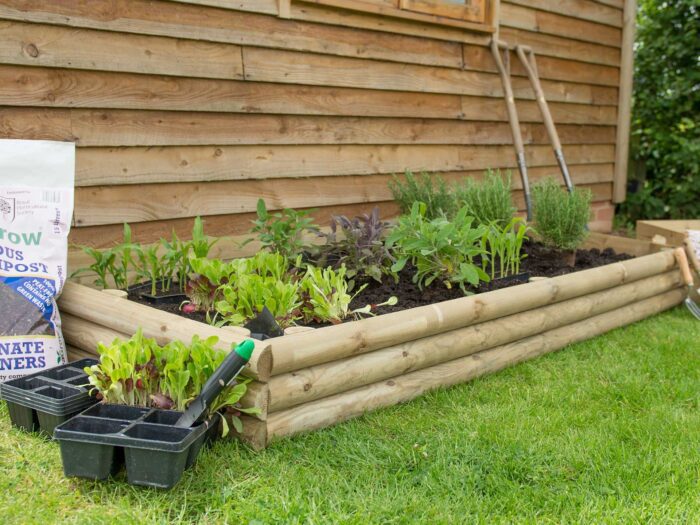
Plan your planting calendar
While it’s important to know your soil type and what will grow well, it’s also only worth growing things you really love and what you know you will use. Think seasonally (considering when the first and last frosts are) and group your plants accordingly.
Knowing when to plant and when to harvest is key, so start a planting notebook to keep track. RHS has an in depth month-by-month planting guide with tips, so you can keep on track year-round.
Try and be realistic when it comes to what you can manage when it comes to planting. It can be easy to get excited about plants in the garden centre, but you don’t want to over buy and not be able to manage it or have wasted veg.
Good Homes chatted to renowned gardener, You Tube gardening star and author of The Self-Sufficiency Garden, Huw Richards at the RHS Chelsea Flower Show, who gave the tip of not watering your tomatoes for at least a week after planting (this allows their roots to establish), and don’t prune for four to six weeks. He adds that once you’ve tasted a home-grown tomato, you’ll never go back to shop-bought.
Richards also says when it comes to kitchen gardens “salads are perhaps the best money-saving crop out there because they are incredibly productive on a small scale and can be continuously picked and eaten”.
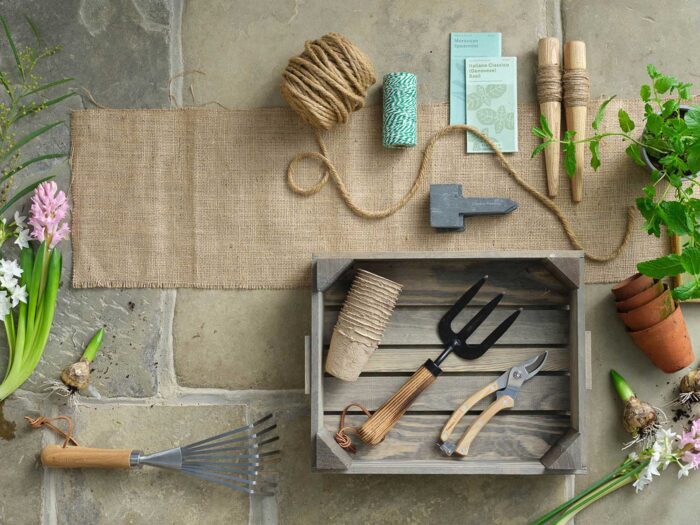
Create a herb garden
If you love cooking, a dedicated herb garden can save you an absolute fortune and provide you with fresh vibrant flavours to add to your dishes. Forest Garden’s rustic-style planting troughs are perfect for creating a kitchen herb garden, but pots also work well. You can also plant them in mixed borders or raised planters.
Based on their life cycles, herbs are roughly categorised into three types: popular annuals (have one life cycle and growing season), biennial herbs (take two years to complete their lifecycle) and perennial herbs (which grow year after year).
Popular annual herbs – Basil, coriander, dill, nasturtium, cress
Biennial herbs – Lovage, caraway, parsley
Perennial herbs – Rosemary, thyme, sage, oregano, mint, tarragon, chives
Herbs love full sun and light. Plant them in well-aerated, well-drained moist soil. They need plenty of organic matter mixed in to the soil for them to grow well.
You can grow herbs from seeds, cuttings, plug plants bought from the garden centre, or you could buy supermarket herb pots and continue their growing.
If you are growing a supermarket herb plant, make sure you divide the plants first, to avoid root crowding. Supermarket herbs are often grown in small pots with multiple seedlings and dividing them will give them more space for better root development.
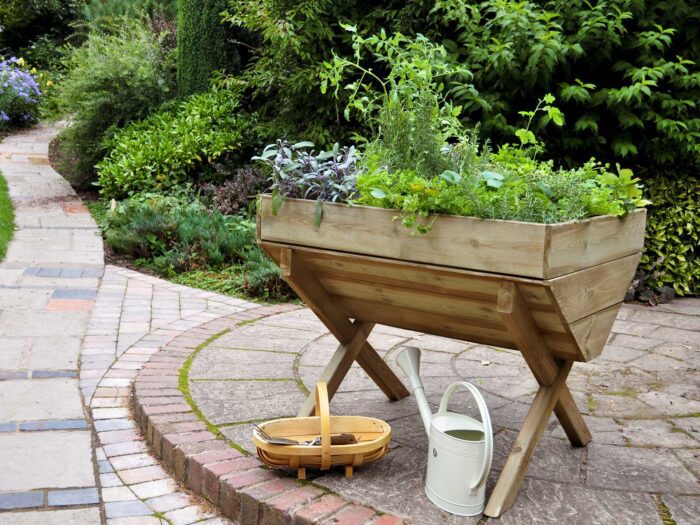
What is edimental planting and why you should consider it
Edimental planting is a portmanteau of edible and ornamental. It both looks beautiful and will yield delicious produce.
Edimentals tend to be perennials, so are resilient and long-lasting, and are generally lower maintenance than a traditional kitchen garden.
Gold medal-winning garden designer Emma Tipping says in her show garden at the RHS Chelsea Flower Show “flowering ornamentals will encourage pollinators for your vegetables. We still tend to think about plants in isolation, but actually, the ecosystem around them is so important.”
To get your edimental garden started, She Grows Veg is a heirloom seed company with a difference. They just won gold for their edimental garden exhibit at the RHS Chelsea Flower Show 2024, stocking an incredible range of exclusively heirloom and open pollinated seed varieties.
Owners Kate and Lucy feel passionately that they want to “help more people grow their own food to save money, eat the freshest, zero food miles, most delicious produce, and a diet packed with nutrients”. Their seeds run the gamut from rainbow coloured sweetcorn to blush coloured chicory rose of Venice, plus a gorgeous selection of edible flowers like giant black pansy, velvet queen sunflowers and nasturtiums.

Think about watering
Dependent on plot size, maintaining a kitchen garden can be a lot of work. Huw Richards suggests a water-saving irrigation of your plant rows in the form of a soaker hose.
A soaker hose is planted within the soil and your plant rows and lets water out at a slow and even rate, at the root of plant (where it’s needed most) in drip irrigation.
The Gardena soaker hose has an installed regulation valve, so you can regulate water flow and pressure to adjust the watering to your garden’s specific needs. This can save up to 70% water compared to a watering can and it means you don’t have to spend hours watering, as it does it for you.
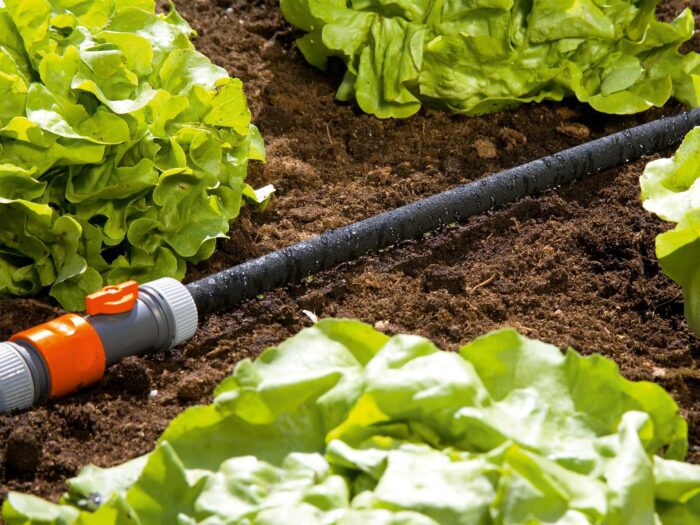
Kitchen gardens to visit for inspiration
Walled kitchen gardens were common place in English country houses for centuries. Across the UK, there are many restored examples to visit for inspiration like the spectacular Gravetye Manor (pictured).
Made from local Sussex sand stone, construction started on the kitchen garden walls in 1898, and today it thrives as it would have done over 100 years ago, growing fruit, vegetables and cut flowers for the manor.
Everything grown in the garden is used in Gravetye Manor’s Michelin-star restaurant. Head Chef George Blogg says that there’s “constant communication between the kitchen and garden teams” and that the “improvisation and flexible nature of the menu make the challenge of growing and cooking vegetables a success and a pleasure for our guests, their health and the environment”.
For more of best kitchen gardens in the UK, try Le Manoir aux Quat’ Saisons in Oxfordshire, Audley End Kitchen and Gardens in Saffron Waldon, Holkham Estate in Norfolk, and the Lost Gardens of Heligan in Cornwall. If you want to delve into the fascinating world of walled kitchen gardens, The Walled Kitchen Garden Network is free to join and runs events all over the UK.
